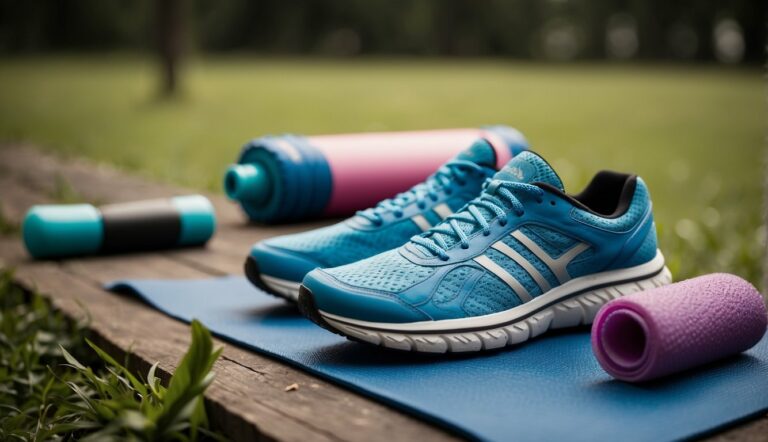The #1 Mistake Runners Make With Cold Weather Running (It’s not what you think!)
You’re ready to run on a cold morning, decked in multiple layers to fend off the chill.
Common sense dictates that the more layers, the better, but here’s the twist: the most common mistake runners make in cold weather isn’t underdressing—it’s overdressing.
This post will reveal why too many layers can backfire and how to strike the perfect balance for winter running.
How Runners Typically Dress for Cold Weather
Standing at the door, you might second-guess your outfit—will it be enough to keep the cold at bay?
It’s a common scenario for runners, but here’s a fact that might surprise you: your body is a natural furnace when you run, quickly heating up even in cold temperatures. Overdressing can lead to overheating, as your body’s heat combined with insulation from too many layers turns your winter run into a steamy workout.
Research at the Cleveland Clinic suggests that runners often overestimate how much insulation they need, leading to excessive sweating and potential discomfort or even hypothermia (Cleveland Clinic). The key is to avoid the trap of overdressing, which we’ll explore further, providing practical advice for dressing just right for your cold runs.
Overdressing – The Number 1 Mistake Runners Make in Cold Weather
The moment you start running, your body begins to generate heat, and those extra layers you thought were necessary can quickly lead to overheating. Overdressing can cause you to sweat more, and in cold weather, this isn’t just uncomfortable—it’s risky.
Excess sweat can make your clothes damp, which may lead to a rapid loss of body heat as soon as you slow down or stop. This increases the risk of hypothermia, where your body temperature drops to dangerously low levels, impairing your physical and mental capabilities.
The body’s sweat response doesn’t significantly change with the temperature of the environment, meaning you’ll sweat nearly as much in cold conditions as you would in warmer settings if you’re overdressed.
This counterintuitive fact underscores the importance of resisting the urge to put on too many layers before a winter run.
Why Overdressing is a Problem for Runners in the Winter
When you overdress, you interfere with your body’s natural ability to regulate temperature. The heat produced by your muscles during a run is more than enough to keep you warm when you’re moving, even in the cold. Overdressing can lead to a host of issues:
- Overheating: Your core temperature can rise to an uncomfortable level, causing symptoms like dizziness or nausea.
- Sweat-chill effect: Once you stop running, the sweat can cool rapidly, chilling you quickly.
- Dehydration: Excessive sweating can lead to dehydration, even in cold weather, because you may not feel as thirsty.
- Impaired performance: Carrying extra weight from heavy clothing and dealing with the discomfort of overheating can hinder your running performance.
To avoid these problems, it’s crucial to dress in layers that can be easily removed as your body warms up. The American Council on Exercise recommends starting with a base layer that wicks sweat away from your body, followed by an insulating layer, and finally a protective outer layer that is wind and water-resistant (American Council on Exercise).
This strategy allows you to stay warm without overheating and provides the flexibility to shed layers as needed during your run.

How to Dress Appropriately for Cold Weather Runs
Choosing the right attire for cold weather running isn’t about piling on as many layers as possible; it’s about selecting smart, functional pieces that work together to regulate your body temperature.
Runners should start with a moisture-wicking base layer that keeps sweat away from their skin. Add an insulating layer, like a fleece or a soft-shell jacket, which traps heat without being overly bulky. Top it off with a breathable, wind-resistant shell to protect against the elements.
Remember, the goal is to feel slightly cool when you start your run, as you’ll warm up once you get moving.
It’s also helpful to follow the “20-degree rule,” which suggests dressing for a run as if it’s 20 degrees warmer than the actual temperature. This accounts for the increase in body temperature once you start exercising.
For example, if it’s 30 degrees Fahrenheit outside, dress as though it’s 50 degrees. This method can help prevent overdressing and the problems that come with it.

Important Accessories for Cold Weather Running
Accessories are your best friend when it comes to cold weather running because they can be easily removed and stored if you start to overheat.
A hat and gloves can significantly affect your comfort level, as a lot of body heat is lost through the head and hands. Look for accessories made of breathable, moisture-wicking materials that offer warmth without causing you to sweat excessively.
Also, consider the use of gaiters or waterproof shoes to keep your feet dry if you’re running through snow or slush. Keeping extremities dry is crucial to maintaining a comfortable body temperature and preventing conditions like frostbite in very cold temperatures.
In the next sections, we’ll provide real-life success stories and practical tips to help you avoid the common pitfall of overdressing, ensuring your cold weather runs are safe, comfortable, and enjoyable.
Practical Tips to Avoid Overdressing
To strike the perfect balance between staying warm and avoiding overheating, here are some practical tips:
- Layer Wisely: Use the three-layer system—base, insulating, and shell—but choose materials that are lightweight and breathable. Your base layer should wick sweat away, the insulating layer should retain heat, and the shell should block wind and repel water.
- Test and Adjust: Before heading out, test your gear in the current weather for a short period. If you feel too warm before starting your run, remove a layer.
- Zip It: Choose apparel with zippers at the neck and underarm areas to vent out excess heat once you start to warm up.
- Be Flexible: Be prepared to shed layers mid-run. Lightweight running vests or belts can store gloves or a hat once you’re warmed up.
- Avoid Cotton: Cotton absorbs and retains moisture, which can lead to a chill. Opt for synthetic fibers designed for exercise.
- Monitor Sweat: Pay attention to how much you’re sweating. If you find yourself drenched early into your run, it might be time to shed a layer.
- Accessorize Smartly: Hats and gloves should be made of moisture-wicking fabric. Consider mittens if your fingers get cold easily, as they allow for shared body heat.
- Stay Dry: Wet skin cools much faster than dry skin, so ensure your outer layer is water-resistant to prevent snow and rain from soaking through.
Success Stories: Runners Who Got It Right
Hearing from runners who have mastered the art of dressing for cold weather can provide both inspiration and proof that these strategies work.
For instance, a runner from Minnesota, where winters are notoriously harsh, shared that by using a moisture-wicking base layer and a thermal, breathable jacket, she could maintain a comfortable temperature throughout her runs, even when the thermometer dipped below freezing.
Another runner from Colorado found that by wearing a light fleece with a wind-resistant vest over the top, he could easily remove the vest and tie it around his waist when he started to feel too warm, without interrupting his stride.
These stories highlight the importance of being adaptable and responsive to your body’s needs. By following the tips outlined above and learning from others who have successfully navigated cold weather running, you can minimize the risk of overdressing and enjoy a safer, more effective workout.

Conclusion
Overdressing for cold weather runs is a mistake that’s easy to make but can have uncomfortable and even dangerous consequences.
By understanding how your body reacts to exercise in the cold and adopting a strategic approach to layering, you can avoid the common pitfalls of winter running. Remember to start with a moisture-wicking base layer, add an insulating layer for warmth, and finish with a protective shell to shield against the elements.
Use accessories to regulate your temperature and be prepared to adjust your layers as you run.
The key takeaway is that feeling a bit cool at the start of your run is a good sign—you should dress for how you’ll feel mid-run, not the first mile. By following the practical tips and learning from the success stories of other runners, you can stay comfortable and perform at your best, even when the mercury drops.
So next time you gear up for a cold run, resist the urge to over layer, trust in your body’s natural heat, and enjoy the crisp winter air with confidence.





![Is Running in the Heat Good for You? [4 Helpful Benefits & 3 Dangers]](https://yournext.run/wp-content/uploads/2022/12/is-running-in-the-heat-good-for-runners_featured-768x512.png)
